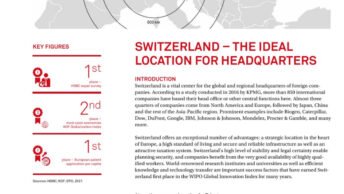
The comparison may be surprising at first glance. Because the city and island state is only about the size of the canton of Glarus, but without mountains and with a tropical climate. Nevertheless, more than 6 million people live in this small area – the population density is much higher than in Switzerland. In addition, the Republic of Singapore is much younger. It was only created in 1965 with the involuntary withdrawal from Malaysia.
Shortly afterwards, industrialization began in Singapore – about 100 years later than in Switzerland. But the rise of Singapore is amazing: in 1965, the per capita income was still around 500 dollars, making the city-state one of the poorest countries in the world. Today, Singapore is one of the richest countries in the world with a GDP of around $140,000 per capita adjusted for purchasing power. There are also differences in terms of the form of government: Singapore is a directed democracy with a centralist state structure and a government that has been provided by the same party since 1959.
However, there are also many similarities: As small states, both Switzerland and Singapore have to make a special effort to be heard internationally. Their economic structure is also similar. Both countries have few natural resources, are dependent on trade and have a financial center with international appeal. That is why they attach great importance to training, innovation and the availability of highly qualified workers.
In the “Global Innovation Index” of the World Intellectual Property Organization (Wipo), Switzerland is in first place and Singapore in fourth. And – what many may not know – Singapore is also multicultural and has four national languages: Mandarin, Malay, Tamil and English, with English being the mandatory language of instruction in all Singapore’s schools since 1987. Due to their diverse societies, both countries take great care to maintain internal peace and protect ethnic and religious minorities.
Same Goals, Same Interests
Both states are pronounced trading nations. Trade in goods and services measured by GDP in Switzerland in 2023 was 138 percent. In Singapore, it was 311 percent. It is therefore not asurprising that both countries are strong supporters of free trade and an effective World Trade Organization (WTO).
From a bilateral point of view, the free trade agreement with the European Free Trade Association (EFTA), which includes Switzerland as well as Norway, Iceland and Liechtenstein, is particularly important. The agreement should soon be supplemented by a digital economic agreement that extends free trade to digital goods and services such as online courses or fintech products and creates more legal certainty.
The high Swiss direct investment in Singapore is also noteworthy. In 2023, this amounted to around 63 billion francs. They are thus higher than the Swiss investments in China, India, Japan and South Korea combined. After all, Singapore is also the country with the highest foreign presence of Swiss universities: ETH Zurich, the University of St. Gallen (HSG), the IMD Lausanne and the Hotel School Lausanne (EHL) have local branches. They carry out research in the field of urbanization (ETH), offer tailor-made programs for their students (HSG, EHL) or are active in management training (IMD, HSG).
Different Economic Policies
Switzerland and Singapore are also similar in terms of liberal economic order, efficient administration and practically non-existent corruption. According to the “Corruption Perceptions Index” of the non-governmental organization Transparency International, Singapore is in 3rd Rank, Switzerland two places behind.
On the other hand, the two countries have different approaches to economic policy. While Switzerland usually sets the framework conditions and leaves everything else to private initiative (“bottom-up”), Singapore has less fear of contact with industrial policy: Much is strategically planned and implemented by the government (“top-down”). For example, there are more than 20 “Industry Transformation Maps”, which set the strategic direction and implementation goals for a large part of the industrial sectors over five years.
Both countries boast of a solid and cautious financial policy. On the revenue side, however, the Swiss financial system is much more decentralized compared to Singapore due to tax competition between municipalities and cantons. Although the maximum income tax rate for private individuals in the city-state is the majority of 24 percent lower than in Switzerland, where it is well over 30 percent in some cantons with high incomes.
However, a rate of 17 percent applies to corporate taxes in Singapore, which makes Switzerland generally more competitive in several cantons. This is likely to be somewhat equalized in the future due to the OECD minimum tax for large internationally active companies accepted by both countries.
High Debt Due to Government Reserves
It is interesting to look at the national debt. In Switzerland, the gross debt ratio (gross debt as a share of GDP) is about one third of GDP, in Singapore it is 175 percent. With all the similarities: how can that be? The reason is that Singapore incurs debt, among other things, to promote its own capital market, to finance large infrastructure projects (port, airport, land reclamation) or to manage state reserves.
The debt is therefore not used to finance current government spending, but to make investments, which in turn can yield income. The high government debt is thus offset by even higher reserves: The state investment fund Temasek, for example, invests directly in companies with a focus on Singapore and the rest of Asia. It has a net worth of $291 billion.
The GIC sovereign wealth fund is more conservative and invests in securities, real estate and other assets worldwide. He currently manages assets of an estimated $800 billion. Both have in common that they invest in the long term and strategically, also taking into account sustainability criteria.
Like Switzerland, Singapore also has a kind of debt brake: The government is obliged to present a balanced budget for the duration of its mandate. In practice, there is often a surplus. There are limits for earnings from previous reserves – which also include Temasek and GIC: a maximum of 50 percent of the long-term income of the sovereign wealth funds may be used for the current budget.
The exact amount, as well as all other withdrawals from the previously accumulated reserves, require the approval of the government and the president (“double lock”). In the past, the reserves were used during the 2008 financial crisis and the Covid-19 pandemic.
The sovereign wealth funds give Singapore security and financial leever in uncertain times. At the international level, they are an attractive location factor because they keep Singapore’s tax burden low, attract innovative companies and open up personnel networks.
Switzerland as a Role Model
Switzerland has an excellent reputation in Singapore: On the one hand, the first Prime Minister Lee Kuan Yew studied Switzerland and its success factors after the founding of the state. On the other hand, his successor, Goh Chok Tong, already formulated the goal in the 1980s that Singapore should achieve “Swiss standards of living” by 1999.
In addition, Switzerland is very visible on the ground: The Swiss community consists of 2600 people and around 450 Swiss companies, which are responsible for more than 25,000 jobs. In addition to the four universities mentioned, our country is represented with the Swiss Club founded in 1871 (by the way, one of the largest private landowners in Singapore), the Swiss Embassy, a Swiss school, the Chamber of Commerce, a Swiss association and an office of the Swiss National Bank.
Although more than 10,000 km away, Switzerland is therefore very present in the city-state, and the designation of Singapore as the Switzerland of Asia is therefore also quite justified.
Blog Source








